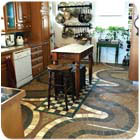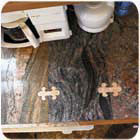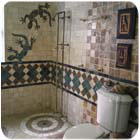
In the kitchen of a St. Croix residence, the floor features a rectangular checkerboard design complemented on both sides by symmetrical wavy “lines.†The geometric patterns were formed with a mix of stone pieces from 18 tons of “scrap†that the homeowners purchased from a supplier in Florida.
The house built by Steffen Larsen and his wife, Jan Mitchell, is a labor of love that has been in the works for approximately eight years. Located in St. Croix, U.S. Virgin Islands, the residence is a reflection of the couple's heritage and creativity. The floors and walls throughout the home, which sprawls somewhere between 4,000 to 5,000 square feet, consist of various types of stone tile - forming flowing patterns from room to room.
“I had been laying tile in a number of houses on St. Croix,†said Larsen. “Together with my wife, I decided to build our ultimate house. My wife is a very good artist. We made a deal - she'd let me design the floors, and I wouldn't object to what she put on top of them. It's all my design.â€

Intricate details, which were cut on the homeowners' own Flow waterjet, were set into the granite countertops.
Once the couple agreed to proceed with the construction of their new home, they set out on a mission to find building materials. “We went up to Florida and shopped around for tile,†said Larsen. “We became very friendly with a Mexican [supplier] out there. Not really knowing what we intended to do, we bought 18 tons of scrap - some up to 7 feet long. We bought anything he could find. He was going to throw it away anyway, so I said, 'Fill it in a container and ship it down to us.' We paid $100 a ton.â€
Additionally, Larsen and Mitchell purchased 18,000 pieces of 4- x 4-inch tumbled Mexican tile. “We were not sure what we were going to do with them,†said Larsen. “We put it all in our garage. It was like we had our own store. I could look at what we had and decide what I wanted to do in various spaces.

The unique stone details reflect the homeowners' creativity.
Incorporating pieces of history
“On top of that, I realized that our little island of St. Croix has a very old history and thousands of ruins lying around that were built mostly by Danes in the 19th century,†Larsen continued. “With my equipment, I realized that if I sliced through the middle of a Danish brick, I could use both sides. There's nothing like it. You cannot copy it. It reeks of history.â€With the desire to incorporate the historical bricks into the design of their new house, the couple placed an ad in the paper, which read, “We buy old brick.†Over a three-year period, they collected 16,000 pieces of Danish brick.
“First, we built the guest house,†said Larsen. “It took about six months. I did it myself. We moved in and then spent the next two years working full-time, and still found time every day to add bits of pieces to the puzzle that became our house.â€
In the main home, various unique stone floor patterns wind throughout the space. “I made it my business not to have a single straight line in my house,†said Larsen. “The design in the middle of the main room is a Gordian Knot. I used a projector on the ceiling to follow the lines.â€
According to Larsen, the dining room design is a mix of granite tile and small glass pieces. In other areas, a combination of brick, marble and granite were used. The focal point in the kitchen is a rectangular checkerboard design, which is complemented by symmetrical wavy “lines†running the full length of the floor on both sides.
“My wife wanted the checkerboard,†said Larsen. “That was the one time she made a request.â€

“Together with my wife, I decided to build our ultimate house,†said owner Steffen Larsen. “My wife is a very good artist. We made a deal - she'd let me design the floors, and I wouldn't object to what she put on top of them. It's all my design.â€
Cutting with a waterjet
To make precise cuts for all the odd-shaped pieces, Larsen used a Flow International waterjet machine. “We didn't buy the waterjet because of the floors,†he said. “We use it in our business to cut glass, which is basically our money maker.â€Larsen explained that his wife is a glass artist, and they own a successful “mom and pop†business in that sector. “Our best advertising is the White House Christmas tree,†he said. “We have supplied the glass ornaments for the past eight or nine years.â€
The Bengal waterjet, which is Flow's smallest model, was purchased many years ago, according to Larsen. “We didn't even know waterjets existed,†he said. “We went to a trade show in Miami looking for a laser, and we became Flow's first customers for the Bengal. They had just finished developing the first little one. They didn't even know if it could cut glass, but they tested the machine for us and it could. We got the first one. The service we have had from them has been magnificent. There is no reason that it can't last forever. It's very high quality.â€

While Larsen relied on his three different-sized diamond blade saws to cut straight tiles, he utilized Flow's Bengal waterjet for more detailed work. “The waterjet is not economical for cutting straight lines,†he said. “I used it for intricate work though. I must say; I love the waterjet. I use it everyday for all kinds of things.â€
All of the floors throughout the home are poured concrete, and the installation was done in a traditional way, according to Larsen. “I used thinset,†he said. “The glass pieces were very thin - 1/8 inch laid against _-inch stone tile. To solve the problem, I epoxied the glass to a piece of stone so that it would be level with the stone pieces.â€
Standing the test of time
In addition to giving thoughtful planning to the home's aesthetic design, Larsen and Mitchell also considered other important details. “It is built to meet hurricane standards,†said Larsen, adding that the couple has their own power source on the property. “I moved to St. Croix in 1988, and I was here for the biggest event - Hurricane Hugo. It took a year to get power back [on the island]. That's why we decided on alternate energy.â€He continued to explain that now that power has become a real issue nationwide, the couple's home has become a showcase. School classes come out to study the power source.
According to Larsen, while a large portion of the home's interior design is now complete, he anticipates about three more years of work. “We started in 1998 and are still going,†he said. “I like the idea that it never finishes.â€
